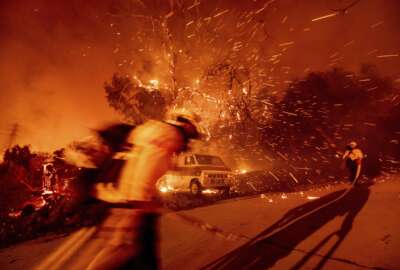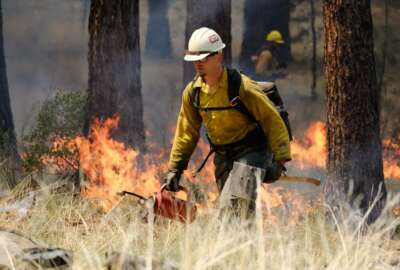
It’s not just low pay causing retention issues for federal firefighters
Although low pay is the most common barrier to retaining federal wildland firefighters, the Government Accountability Office said other factors like poor-work life...
Best listening experience is on Chrome, Firefox or Safari. Subscribe to Federal Drive’s daily audio interviews on Apple Podcasts or PodcastOne.
Although low pay is the challenge most commonly discussed for federal wildland firefighters, it’s not the only factor leading to retention issues with the frontline workforce.
Other challenges, such as poor work-life balance and limited workforce diversity, pile onto the difficulties in retaining these federal employees.
The causes of retention challenges for the workforce are often tied together, too, according to Cardell Johnson, acting director of natural resources and environment at the Government Accountability Office.
“The pay piece is intertwined with the work-life balance piece,” Cardell said in an interview with Federal News Network. “You are working these long hours, you’re getting overtime pay, and you want that pay because you want to be able to afford basic necessities in life. But at the same time, you’re working a lot and you’re not getting that balance you need.”
Overall, there are seven common barriers to recruitment and retention for federal firefighters, a Nov. 17 GAO report said. The report compiled information from the departments of Agriculture and Interior — the two agencies that hire the vast majority of the 18,700 federal firefighters operating around the country — as well as several stakeholders.
Although low pay isn’t the only challenge for the workforce, it is one of the most notable ones, according to agencies and stakeholders in the report.

Most entry-level federal wildland firefighters now make $15 an hour, after agencies implemented a raise in August 2021, up from $13 an hour. But the slight pay bump is not enough to significantly improve employee retention, according to the report.
“The pay increase is intended to compensate firefighters for the hazardous work they perform, while improving the federal agencies’ competitiveness with nonfederal entities,” the report said. “However, even with the increase, officials and eight stakeholders said that the $15-per-hour minimum wage for entry-level positions does not reflect the risk or demands of the work.”
Interior, as well as Agriculture, which houses the U.S. Forest Service, created some incentives to try to offset the low pay. For example, agencies can offer $1,000 to all firefighters at or below level 9 on the General Schedule (GS-09), as well as relocation incentives, since many of the areas with the most dense wildfires also have high costs of living. Regardless, the pay issues still deter some firefighters from taking federal positions.
“I actually met some firefighters in California, who work not for the feds, but for the state, [because] they pay a little bit better than the feds do,” Johnson said. “They say that the reason [they work for the state] is the cost of living. They would love to become a federal firefighter, but can’t because of the cost of living in California.”
There’s also a temporary pay raise under the Infrastructure Investment and Jobs Act (IIJA) for federal firefighters — an extra $20,000 or an added 50% of base salary, whichever is lower — in locations where it is difficult to recruit or retain wildland firefighters. All locations were determined to have these challenges, meaning all federal firefighters will get the raise. But the temporary pay bump will only last for a couple of years.
The National Federation of Federal Employees, the union that represents federal firefighters, is one of several organizations calling for a permanent pay raise for the employees.
“It is critical that firefighters on the front lines of the wildfire crisis are compensated for the hazardous work they do in protecting our public lands and keeping our communities safe,” NFFE National Communications Director Matt Dorsey said in an email to Federal News Network. “In addition to a permanent pay fix, Congress must allocate resources so that agencies can address problems that are detrimental to firefighter recruitment and retention, such as limited career growth, poor work-life balance, mental health challenges and inadequate housing, among others.”
Career advancement was another significant barrier to recruitment and retention of federal firefighters, according to the report. With extensive field work during wildfire season, many employees find it difficult, if not impossible, to attend the necessary training to get a promotion, GAO said.
As part of another directive under the IIJA, though, agencies are working with the Office of Personnel Management to develop a new occupational series for federal firefighters. The creation of the new occupational series would aim to provide a definitive career path and lay out the requirements for career advancement.
“According to officials, the new series should help the agencies recruit and retain new applicants, as well as current firefighters, because they will be able to clearly identify the steps necessary to advance their careers,” the report said.
Currently, 70% of the Forest Service’s wildland firefighter workforce, and 59% of Interior’s wildland firefighter workforce, are at GS-07 or below.
“Classifying firefighting positions under the forestry or range technician occupational series—as most positions have been since 1972—does not recognize the physical demands of, or expertise involved in, firefighting,” the GAO report said. “This has contributed to low morale, as the individuals in these positions take pride in their work as firefighters and want to be recognized for that work.”
The discussions among OPM, Interior and Agriculture are currently underway, to determine exactly how much the GS level and pay would increase under the new occupational series. But Johnson said it would likely eventually yield additional benefits for federal firefighters. The agencies have until next June — a year after the new occupational series was announced — to implement the occupational series.
Even though low pay was the most common concern among agencies and stakeholders, other challenges, such as work-life balance and mental health, are also high on the list of recruitment and retention barriers. Wildfire season has grown longer and more severe in recent years, which in turn has worsened many firefighters’ work-life balance. Even with added seasonal employees during peak wildfire season, many employees cannot, for example, attend routine doctor’s appointments in their very limited time off.
“Things that we probably take for granted, [like] taking a day or a few hours to go visit the doctor, that’s really difficult for a lot of firefighters because the fires don’t stop,” Johnson said. “The limited time that firefighters do get off, they’re trying to spend with their family.”
Additionally, the disproportionately white and male workforce causes issues specifically for retaining women and people of color in federal firefighter positions. In fiscal 2021, 84% of federal firefighters identified as men, and 72% identified as white.
Agencies are trying to increase diversity in the federal firefighter workforce, including through a wildland firefighter apprentice program. In fiscal 2022, women made up more than 20% of the 420 firefighters that the Forest Service recruited through the apprenticeship program, while underrepresented racial and ethnic groups comprised nearly 50%.
But there are additional issues, too. Some women federal firefighters have experienced sexual harassment, the report said.
“Being in a male-dominated environment, even if the sexual assault hadn’t occurred, that certainly raises flags, particularly for women, and they’re cautious about that, because there’s the potential risk for that, especially being in very isolated parts of the country,” Johnson said.
Agencies are starting to implement workforce trainings on the effects of sexual harassment, but it’s too soon to tell if that has impacted the number of occurrences.
Although agencies are trying to do more to improve retention rates overall, it will take more time to measure how much the changes actually help “move the needle,” Johnson said.
“The problem is very complex. There’s not just one challenge, there are multiple challenges here,” he said. “Once we start to see some of that data in the results from that evaluation, we’ll be able to say whether or not these things help. But based on what folks said, the options being explored by the agencies should really help move things forward.”
Beyond the scope of the GAO report, NFFE has advocated for additional measures to support federal firefighters. Those include more focus on medical issues and illnesses, such as studies on environmental exposure, limiting diseases that affect wildland firefighters, and taking better care of sick or injured firefighters after they leave the workforce.
In an effort to improve retirement for federal firefighters, the Senate also unanimously passed the First Responder Fair RETIRE Act last week, which will now move to the president’s desk for signing. The legislation equalizes retirement benefits for federal first responders — including federal wildland firefighters — who get injured on the job. The House unanimously passed companion legislation earlier this year.
NFFE applauded the passage of the bill, and urged legislators to move quickly to take further steps to support the frontline workforce.
“We hope that Congress will seriously consider the findings of the report and take action to implement the solutions NFFE and wildland firefighters have been suggesting,” Dorsey said. “Any further delay will only cause additional harm to an already untenable situation.”
Copyright © 2025 Federal News Network. All rights reserved. This website is not intended for users located within the European Economic Area.
Drew Friedman is a workforce, pay and benefits reporter for Federal News Network.
Follow @dfriedmanWFED




